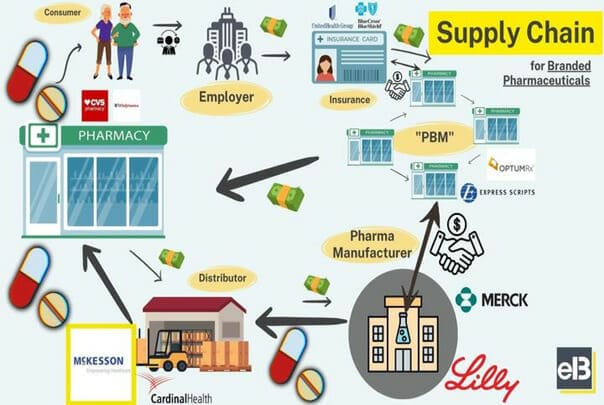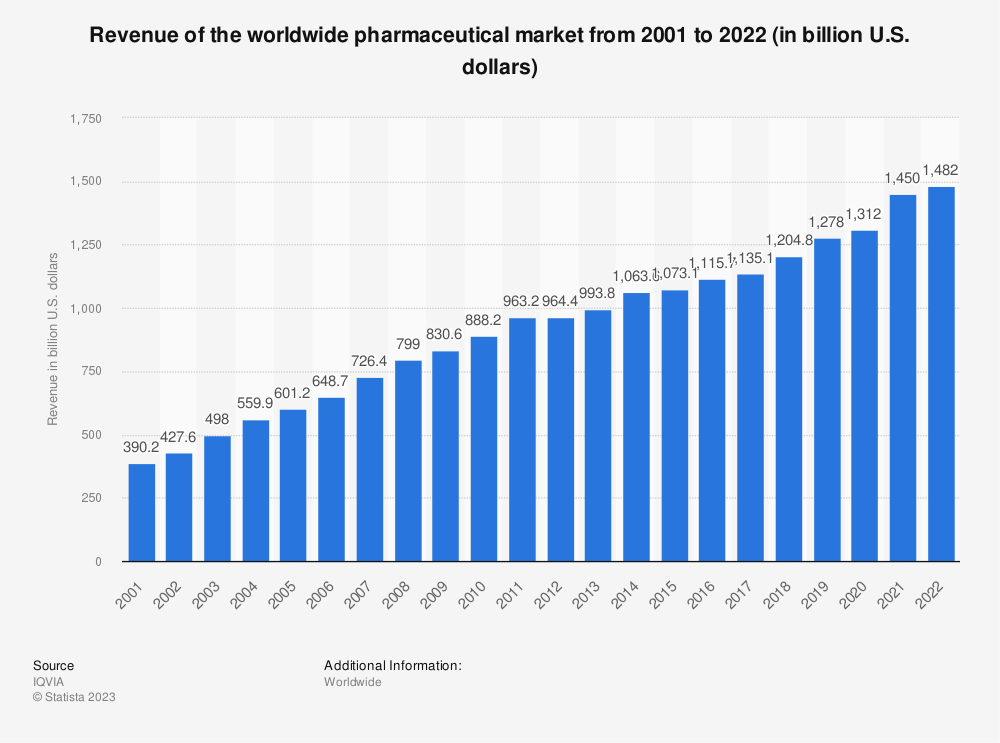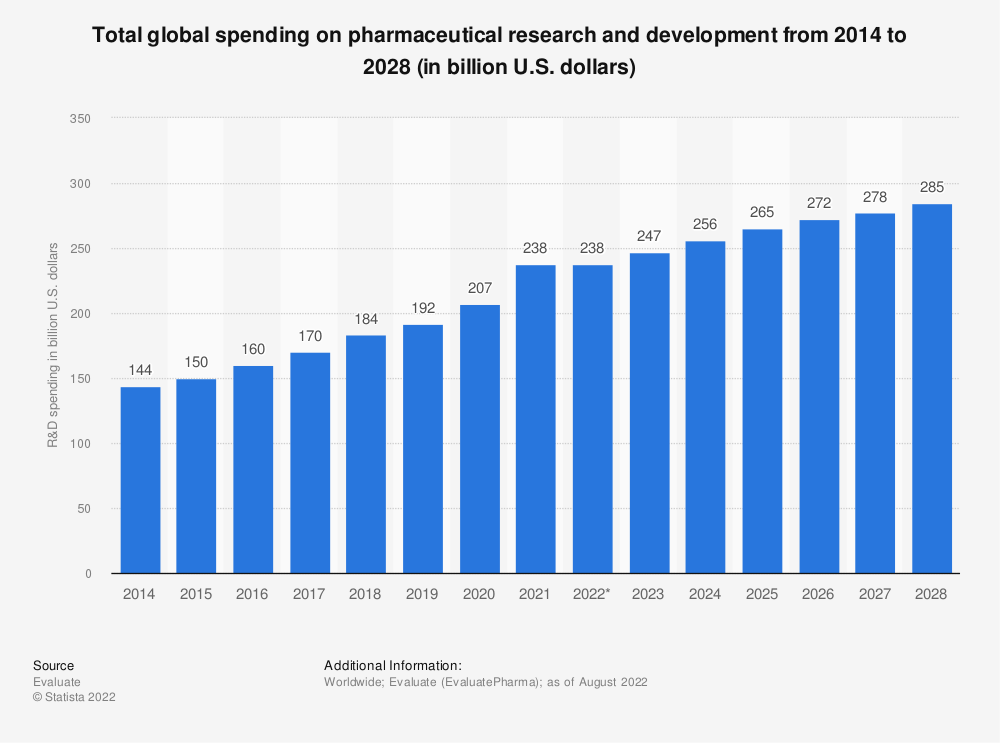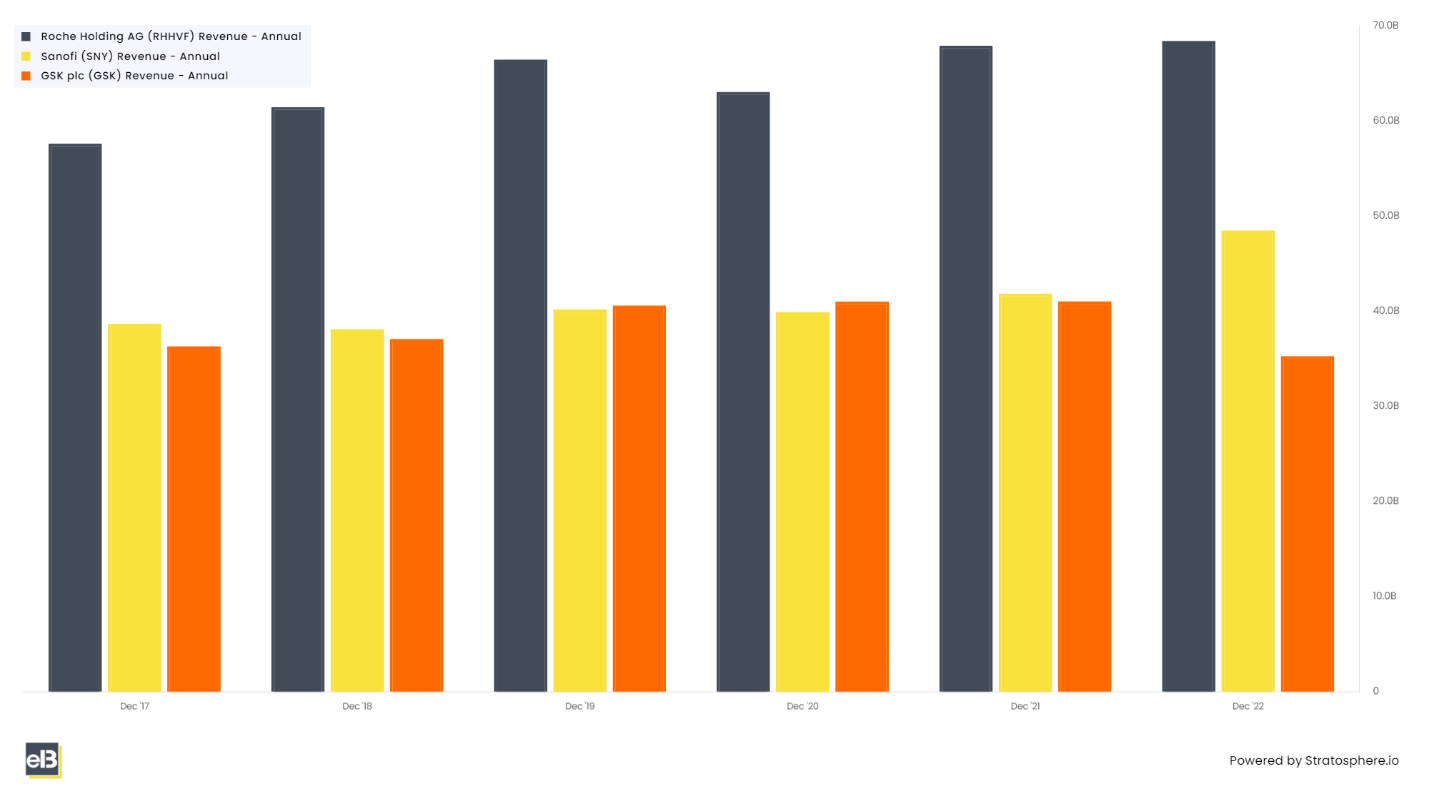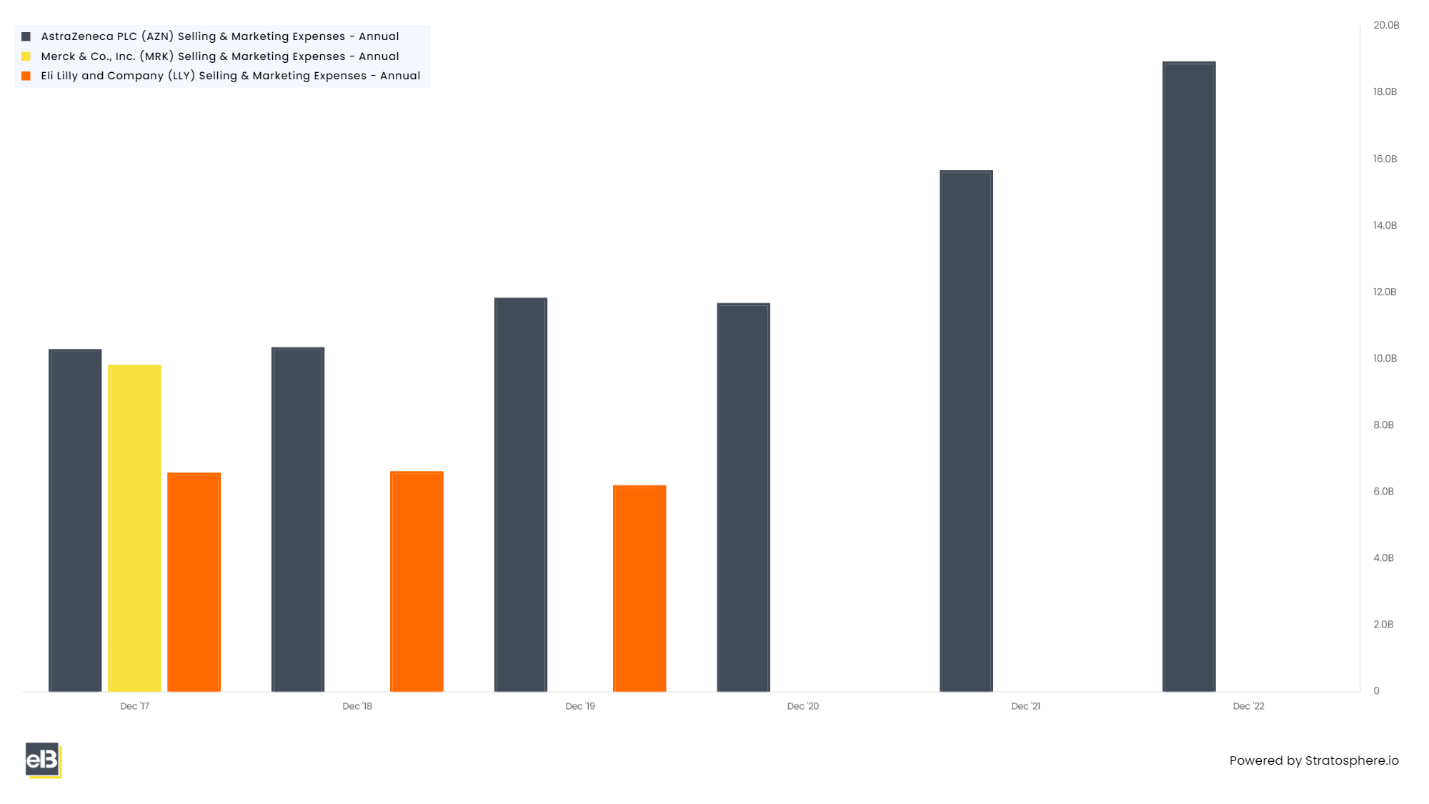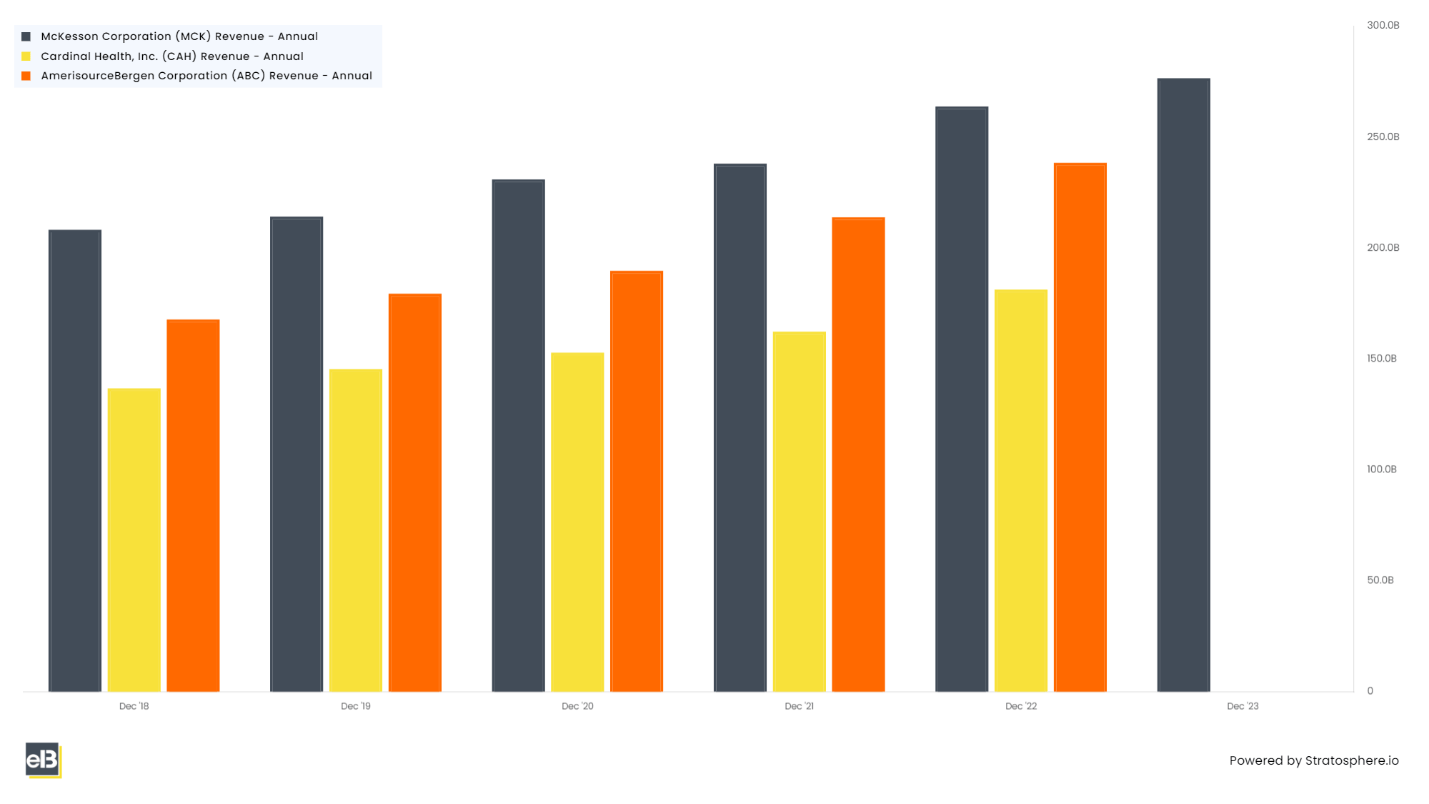Investing in any sector/industry can offer many different challenges. You can often come across a company you like but find another in the value chain you like better. The pharma industry is not different.
For example, we can work backwards in the value chain from a company like Novo Nordisk and find other potential investment opportunities.
Let’s say you like a SaaS company but find you like the cloud provider better or the chip manufacturer who creates the servers.
Many times you can work backwards and find better investment opportunities.
The same idea applies to the pharma industry.
In today’s post, we will learn:
- Short Overview of the Pharma Industry
- Outline the Value Chain of the Pharma Industry
- Research and Development (R&D)
- Manufacturing
- Marketing and Sales
- Distribution and Logistics
- R&D in Generics and Biosimiliars
Okay, let’s dive in and learn more about the value chain of the pharma industry.
Short Overview of the Pharma Industry
The pharmaceutical industry is a vital sector that is crucial in developing and providing medications to people worldwide. It involves various stages and processes to ensure safe and effective drugs reach those in need.
Understanding the value chain concept is important in comprehending how the pharmaceutical industry functions.
A value chain represents the activities involved in creating a product or service, from its initial development to its distribution and beyond.
In the pharmaceutical industry, the value chain encompasses all the steps needed to bring a drug from the research and development stage to its availability in pharmacies and hospitals.
We will focus on the drug makers, manufacturers, and distribution. The insurance aspect of the chain is a whole other can of worms we can discuss another day.
Understanding this value chain gives us insights into the different stages and the important players.
Why is it important to grasp the value chain in the pharma sector?
Well, it allows us to appreciate the complexity of the industry and the collaborative efforts required to develop, manufacture, and distribute medications.
It helps us understand how pharmaceutical companies work with regulatory authorities, healthcare professionals, and various stakeholders to ensure safe and effective drugs are available to patients.
Moreover, understanding the value chain helps us recognize the significance of each stage in the process, from research and development, where new drugs are discovered and tested, to manufacturing and production of these drugs on a larger scale, and finally to distribution and sales, where they reach the hands of patients in need.
Each stage has its challenges, regulations, and key players, all working together to ensure the availability of life-saving medications.
In the following sections, we will delve into the different components of the pharmaceutical industry’s value chain and highlight some publicly traded companies involved in each part.
This exploration will provide a glimpse into the intricate workings of the industry and shed light on the diverse entities that contribute to the development and distribution of pharmaceutical products.
Outline the Value Chain of the Pharma Industry
The value chain of the pharma industry has multiple layers, and many companies occupy many different layers of the value chain.
For example, Johnson & Johnson creates, manufactures, and markets many of the drugs they sell.
Here is the value chain we will explore today:
- R&D
- Manufacturing
- Marketing and Sales
- Distribution and Logistics
- R&D in Generics and Biosimiliars
I didn’t create the post as an exhaustive resource but rather an overview, including some of the bigger players in each layer.
Understanding the value chain will also give you a better understanding of the industry and what might impact companies you already own.
For example, if the manufacturer has issues, it will affect the distribution.
The goal is to offer the opportunity to see how the value chain moves from creation to drug use. Plus, it can provide investment opportunities if you find one level of the chain too unpredictable or volatile for your tastes.
Research and Development (R&D)
Research and Development (R&D) is a crucial aspect of the pharmaceutical industry that focuses on discovering and developing new drugs and therapies. It is vital in improving human health and addressing various medical challenges.
Let’s explore the importance of R&D in drug discovery and development and some major pharmaceutical companies involved in this critical stage.
R&D is the foundation of the pharmaceutical industry, as it drives innovation and the creation of new medications.
Through extensive scientific research and experimentation, pharmaceutical companies strive to uncover new drugs that can treat diseases, alleviate symptoms, and enhance the quality of life for patients.
Drug discovery and development begins with identifying potential targets, such as specific proteins or genetic factors, that play a role in disease. Scientists then design and test various compounds to interact with these targets, aiming to find molecules that show promising therapeutic effects.
This early stage, known as preclinical testing, involves laboratory experiments and animal studies to evaluate the safety and effectiveness of potential drugs.
Promising compounds that pass preclinical testing move on to clinical trials involving rigorous testing in human volunteers. Clinical trials are conducted in multiple phases to assess the drug’s safety, dosage, and efficacy. These trials provide critical data on the drug’s effectiveness, side effects, and potential interactions with other medications.
The research and development process can be lengthy, often taking many years and involving significant investments.
However, successful outcomes can lead to groundbreaking discoveries and the development of life-saving treatments. R&D is the backbone of the pharmaceutical industry’s commitment to advancing medical science and improving patient care.
Several major pharmaceutical companies are actively involved in research and development, continuously striving to innovate and bring new drugs to market. Statista estimates that R&D spending will grow to $285 billion by 2028.
Here are three notable companies making significant contributions in this field:
1. Pfizer Inc. (PFE): Pfizer is a leading global pharmaceutical company known for its extensive R&D efforts. It focuses on various therapeutic areas, including vaccines, oncology, cardiovascular health, and immunology. Pfizer has significantly contributed to developing numerous medications that have positively impacted patient health worldwide.
2. Novartis International AG (NVS): Novartis is a multinational pharmaceutical company committed to R&D and discovering innovative treatments. It conducts research across diverse therapeutic areas, such as neuroscience, ophthalmology, immunology, and oncology. Novartis has a strong track record of introducing breakthrough therapies that address unmet medical needs.
3. Johnson & Johnson (JNJ): Johnson & Johnson, a well-known healthcare conglomerate, is actively involved in pharmaceutical R&D. Its pharmaceutical segment focuses on areas such as immunology, oncology, infectious diseases, and cardiovascular health. The company’s commitment to R&D has led to the development of numerous successful drugs and therapies.
Other big spenders on R&D include the following:
- Novo Nordisk (NVO)
- Eli Lilly (LLY)
- Roche (RHHBY)
- Merck (MRK)
These companies and many others invest substantial resources in R&D to drive innovation and improve patient outcomes.
Their efforts in drug discovery and development contribute to the advancement of medical science and the availability of new and effective treatments for various diseases.
In conclusion, research and development are pivotal in the pharmaceutical industry. R&D efforts lead to the discovery of new drugs and therapies that can transform healthcare and improve patients’ lives worldwide.
Manufacturing
Manufacturing plays a crucial role in the pharmaceutical industry by ensuring the efficient production of high-quality medications.
Let’s explore the significance of efficient and high-quality manufacturing processes in the pharmaceutical sector and some prominent pharmaceutical companies known for their strong manufacturing capabilities.
For several reasons, efficient and high-quality manufacturing processes are vital in the pharmaceutical industry.
Firstly, they ensure that medications are produced consistently and reliably, meeting strict regulatory standards and quality control measures. This is crucial to guarantee pharmaceutical products’ safety, efficacy, and reliability.
Secondly, efficient manufacturing processes enable pharmaceutical companies to produce medications on a large scale, ensuring an adequate supply to meet the demands of patients and healthcare providers. By optimizing production efficiency, companies can reduce costs, minimize waste, and improve the accessibility and affordability of medications.
Moreover, robust manufacturing processes enable companies to respond effectively to sudden increases in demand, such as during disease outbreaks or public health emergencies. Flexibility and scalability in manufacturing operations allow pharmaceutical companies to produce and distribute medications to address urgent medical needs rapidly.
Several prominent pharmaceutical companies are known for their strong manufacturing capabilities. Here are three examples:
1. Roche Holding AG (RHHBY): Roche is a leading pharmaceutical company with a reputation for advanced manufacturing processes. It specializes in producing innovative medications in various therapeutic areas, including oncology, immunology, and infectious diseases.
2. Sanofi (SNY): Sanofi is a global pharmaceutical company recognized for its robust manufacturing operations. With a diverse portfolio of medications spanning areas such as diabetes, vaccines, and rare diseases, Sanofi emphasizes efficient production processes to ensure the availability of life-saving treatments.
3. GlaxoSmithKline PLC (GSK): GlaxoSmithKline (GSK) is a renowned pharmaceutical company prioritizing manufacturing excellence. GSK focuses on various therapeutic areas, including respiratory health, vaccines, and infectious diseases. By maintaining high manufacturing standards, GSK ensures that its medications adhere to strict quality control measures, benefiting patients and healthcare professionals.
These pharmaceutical companies and others invest in state-of-the-art manufacturing facilities, cutting-edge technologies, and robust quality management systems. By doing so, they uphold the highest standards of manufacturing practices to deliver safe and effective medications to patients globally.
Marketing and Sales
Marketing and sales play a vital role in the pharmaceutical industry by promoting and making pharmaceutical products available to healthcare professionals and patients.
Marketing and sales activities in the pharmaceutical industry serve several important functions.
1. They create awareness about new medications, ensuring that healthcare professionals and patients know their benefits and potential uses.
This helps physicians make informed decisions when prescribing medications and enables patients to understand their treatment options.
2. Marketing and sales efforts contribute to building trust and credibility in pharmaceutical brands. Through targeted advertising, educational campaigns, and interactions with healthcare professionals, pharmaceutical companies establish themselves as reliable sources of medical information. By providing accurate and up-to-date information, they aim to foster confidence in the effectiveness and safety of their products.
Moreover, marketing and sales teams work closely with healthcare professionals to ensure the right medications reach patients. They provide product samples, educational materials, and support programs to assist healthcare professionals in prescribing and utilizing pharmaceutical products effectively.
Several pharmaceutical companies excel in their marketing and sales strategies. Here are three noteworthy examples:
1. Merck & Co., Inc. (MRK): Merck is a global pharmaceutical company known for its strong marketing and sales initiatives. The company employs targeted advertising campaigns and educational programs to promote its medications.
2. AstraZeneca PLC (AZN): AstraZeneca is a pharmaceutical company recognized for innovative marketing approaches. The company utilizes digital marketing channels and collaborations with healthcare professionals to raise awareness about its medications.
3. Eli Lilly and Company (LLY): Eli Lilly is a pharmaceutical company that excels in marketing and sales through its customer-centric approach. The company focuses on understanding the needs of healthcare professionals and patients and tailors its marketing efforts accordingly.
These pharmaceutical companies invest in market research, targeted advertising campaigns, and strong sales teams to effectively promote their products.
By employing innovative marketing strategies, they ensure that healthcare professionals and patients have access to the information they need to make informed decisions about pharmaceutical treatments.
Marketing and sales play a crucial role in the pharmaceutical industry. They create awareness about new medications, establish trust and credibility, and facilitate the appropriate use of pharmaceutical products.
Distribution and Logistics
Efficient distribution and logistics are crucial in the pharmaceutical industry as they ensure that medications reach consumers promptly and reliably.
In the pharmaceutical industry, efficient distribution networks are of utmost importance to ensure the delivery of medications to the right place, at the right time, and in the right condition. Timely access to medications is essential for patients, especially those with critical or chronic illnesses who depend on a consistent supply of their prescribed treatments.
Efficient distribution networks help streamline getting medications from manufacturing facilities to pharmacies, hospitals, and ultimately, patients.
These networks involve a complex web of transportation, warehousing, and logistics management, ensuring that medications are stored, handled, and transported under optimal conditions to maintain their integrity and efficacy.
Furthermore, efficient distribution networks contribute to the overall healthcare system by minimizing delays and disruptions in the availability of medications.
By ensuring a smooth flow of pharmaceutical products, they help healthcare providers meet the needs of their patients and maintain a reliable supply chain.
Several pharmaceutical companies have established robust distribution capabilities to deliver medications to consumers efficiently.
Here are three leading examples:
1. McKesson Corporation (MCK): McKesson is a global healthcare service and pharmaceutical distribution company. It operates an extensive distribution network that spans the entire pharmaceutical supply chain, from manufacturers to pharmacies and healthcare institutions. McKesson’s distribution expertise allows it to deliver medications and healthcare products to diverse healthcare settings efficiently.
2. Cardinal Health, Inc. (CAH): Cardinal Health is a superior healthcare services and products company specializing in pharmaceutical distribution. It operates a vast network of distribution centers and logistics infrastructure, ensuring the efficient delivery of medications to various healthcare providers.
3. AmerisourceBergen Corporation (ABC): AmerisourceBergen is a leading pharmaceutical services company focusing on distribution and logistics. It operates a comprehensive distribution network that spans the entire pharmaceutical supply chain, including manufacturers, pharmacies, and healthcare facilities.
These pharmaceutical companies invest in advanced logistics technologies, cold chain management systems, and stringent quality control measures to ensure the safe and efficient distribution of medications.
Their robust distribution capabilities support the reliable supply of pharmaceutical products, allowing patients to receive the treatments they need promptly and consistently.
The pharmaceutical industry’s efficient distribution and logistics are vital components. They play a crucial role in ensuring that medications reach consumers promptly and reliably.
R&D in Generics and Biosimiliars
Research and development (R&D) of generics and biosimilars is a significant aspect of the pharmaceutical industry.
Generics and biosimilars play a crucial role in expanding patient access to affordable medications.
Let’s explore what generics and biosimilars are and highlight key pharmaceutical companies involved in their development.
Generics are medications developed and marketed after the patent protection of the original branded drugs expires. These medications contain the same active ingredients as their brand-name counterparts and are equivalent in dosage form, strength, route of administration, quality, and performance.
Generics provide cost-effective alternatives to brand-name drugs, making healthcare more accessible and affordable for patients.
On the other hand, biosimilars are biological products that are highly similar to already approved reference biological drugs. Companies developed biosimilars to be as effective and safe as the reference biologics, which are complex medications made from living organisms.
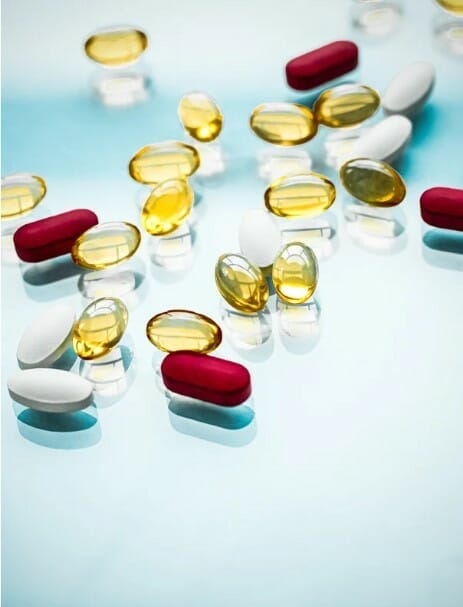
Unlike generics, which companies chemically synthesize, pharma companies manufacture biosimilars using living cells, making their development more intricate. Biosimilars allow patients to access effective biological treatments at reduced costs.
Several pharmaceutical companies are leading the way in the research and development of generics and biosimilars.
Here are three notable examples:
1. Teva Pharmaceutical Industries Limited (TEVA): Teva is one of the world’s largest generic pharmaceutical companies. It has a robust portfolio of generic medications dedicated to expanding patient access to affordable healthcare. Teva invests significantly in R&D to develop high-quality generics that meet rigorous regulatory standards.
2. Mylan N.V. (MYL): Mylan is a global pharmaceutical company focusing strongly on generics and biosimilars. It has a diverse range of generic medications and is a prominent player in the biosimilar market.
3. Biocon Limited (BIOCON.NS): Biocon is an Indian biopharmaceutical company specializing in biosimilars. It has significantly advanced in developing biosimilar drugs for various therapeutic areas, including oncology, immunology, and diabetes.
These pharmaceutical companies invest substantial resources in R&D to ensure the safety, efficacy, and quality of generics and biosimilars.
Investor Takeaway
The pharmaceutical industry encompasses various stages in its value chain, each playing a crucial role in bringing safe and effective medications to patients.
From research and development to manufacturing, marketing and sales, distribution and logistics, and the development of generics and biosimilars, numerous pharmaceutical companies contribute to the advancement of healthcare.
Companies like:
- Pfizer
- Novartis
- Johnson & Johnson
- Roche
- Sanofi
- GlaxoSmithKline
- Merck
- AstraZeneca
- Eli Lilly
- McKesson
- Cardinal Health
- Teva Pharmaceutical Industries
These twelve companies are notable players that excel in their respective areas.
It also gives us a great starting point for analyzing or investigating each company. If you want to start investing in the pharma world, you don’t need to only focus on the drug makers. You can also look deeper at the manufacturing or distributors, for example.
Understanding the value chain in the pharmaceutical industry helps us recognize the complex processes involved in bringing medications from conception to the hands of patients.
And with that, we will wrap up our discussion regarding the value chain for the pharma industry.
Thanks for reading, and I hope you find something of value here. If I can further assist, please don’t hesitate to reach out.
Until next time, take care and be safe out there,
Dave
Related posts:
- Guide to Investing in the Pharma Industry Did you know the revenues for the global pharmaceutical markets in 2022 equaled $1.48 trillion? It had grown from $390 billion in 2002, a CAGR...
- Difference Between Operating Leverage and Economies of Scale “Do you know the difference between operating leverage and economies of scale? Seriously, take a moment to define the terms clearly (I did not know...
- What are Selling, General, & Administrative Expenses? In the tech world, SG&A costs occupy a large part of the company’s costs. For many companies, these costs will inevitably occupy a high cost...
- Understanding the 12 Most Common Types of Business Models Updated 4/4/2024 In a speech in Switzerland, Warren Buffett discussed what he means by buying businesses he understands. “We don’t look for specific sectors; we...

